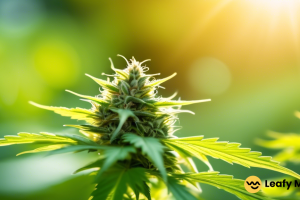Welcome to the fascinating world of culinary cannabis! With the increasing legalization and acceptance of cannabis in many parts of the world, incorporating this versatile plant into your cooking has never been easier or more enjoyable.
This article will explore the tips and tricks that can transform your time in the kitchen into a fun and informative experience while unlocking the potential of cannabis as a unique and flavorful ingredient. From selecting the right strains to mastering the art of infusion, we’ll guide you through cooking with cannabis, so you can confidently create delectable dishes that will delight your taste buds and expand your culinary horizons.
Table of Contents
- 1.Understanding the Basics: A Brief Overview of Cannabis
- 2.Choosing the Right Strain: Flavor and Effect Profiles
- 3.Decarboxylation: Activating Your Cannabis for Cooking
- 4.Infusion Essentials: Oils, Butters, and Tinctures
- 5.Mastering the Art of Cannabis-Infused Baking
- 6.Savory Delights: Cooking with Cannabis in Main Courses
- 7.Sweet Treats: Exploring Cannabis-Infused Desserts
- 8.Vegan and Gluten-Free Options: Cannabis Cuisine for All
- 9.Elevating Your Dishes: Pairing Cannabis with Complementary Flavors
- 10.Cooking with CBD: Non-Psychoactive Cannabis Options
- 11.Calculating Dosage: Ensuring a Safe and Enjoyable Experience
- 12.Storage and Shelf Life: Making the Most of Your Cannabis-Infused Creations
- 13.Hosting a Cannabis-Themed Dinner Party: Tips for Success
- 14.Cannabis Mocktails: Adding a Twist to Your Beverages
- 15.The History of Cannabis in Culinary Traditions
- 16.Can I Use Homemade Cannabis Cooking Oil in the Recipes Shared in “Cooking with Cannabis: Tips and Tricks”?
- 17.The Future of Cannabis Cuisine: Trends and Innovations
- 18.The Final Course: Cannabis Cooking
Understanding the Basics: A Brief Overview of Cannabis
Cannabis, also known as marijuana, is a flowering plant used for medicinal, spiritual, and recreational purposes throughout history. It contains over 100 active compounds called cannabinoids, the two most well-known being delta-9-tetrahydrocannabinol (THC) and cannabidiol (CBD).
THC is responsible for the plant’s psychoactive effects, while CBD is non-psychoactive and has potential therapeutic benefits. When cooking with cannabis, it’s essential to understand the basic properties of these compounds to ensure a safe and enjoyable experience.
Choosing the Right Strain: Flavor and Effect Profiles
Selecting the appropriate cannabis strain for your culinary creations is crucial, as each strain has a unique flavor profile and effects. Strains are generally classified as Indica, Sativa, or Hybrid, with each type offering distinct characteristics. Indica strains are known for their relaxing and sedative effects, while Sativa strains provide an uplifting and energizing experience. Hybrids, as the name suggests, are a combination of the two and offer a balance between the properties of Indica and Sativa strains.
When cooking with cannabis, consider the desired outcome and the flavors you want to incorporate into your dishes. For example, an Indica-dominant strain might be a better choice if you’re creating a relaxing dinner. Some strains have unique flavors, such as citrus, pine, or berry, which can complement your dish’s ingredients and enhance the overall taste in sweet recipes like weed ice cream.
Decarboxylation: Activating Your Cannabis for Cooking
Before incorporating cannabis into your recipes, it’s essential to understand the process of decarboxylation. This process involves heating the cannabis to convert the non-psychoactive THCA and CBDA compounds into their active forms, THC and CBD. Decarboxylation ensures that the cannabinoids are readily available and effective when consumed in your infused dishes.
To decarboxylate cannabis at home, preheat your oven to 240°F (115°C). Break up the cannabis into small, evenly-sized pieces and spread them out on a parchment-lined baking sheet. Bake for 30-40 minutes or until the cannabis is golden-brown and dry to the touch. After decarboxylation, your cannabis can be used in your infusion process.
Infusion Essentials: Oils, Butters, and Tinctures
Infusing cannabis into a fat or alcohol-based medium is a popular method for incorporating its flavors and effects into your dishes. The most common mediums for cannabis infusion are oils, butters, and tinctures.
Cannabis-infused oil is versatile and can be used in various recipes, from salad dressings to baked goods. To make cannabis-infused oil, combine your decarboxylated cannabis with carrier oil, such as coconut or olive oil, in a slow cooker or double boiler. Heat the mixture on low for 3-6 hours, stirring occasionally. Once the infusion is complete, strain the mixture through a cheesecloth, discard the plant material, and store the infused oil in an airtight container.
Cannabis-infused butter, or cannabutter, is another popular choice for cooking with cannabis. The process is similar to making infused oil but with butter as the carrier medium. Melt the butter in a saucepan or double boiler, add the decarboxylated cannabis, and heat the mixture on low for 2-4 hours. Strain, cool, and store the cannabutter in an airtight container for use in various recipes.
Tinctures are alcohol-based cannabis extracts that can be easily incorporated into recipes or taken sublingually for a more direct and fast-acting effect. To make a cannabis tincture, combine decarboxylated cannabis with high-proof alcohol, such as Everclear or vodka, in a mason jar. Seal the jar and store it in a cool, dark place for at least two weeks, shaking it daily to help the cannabinoids dissolve into the alcohol. After the infusion, strain the mixture through a cheesecloth to remove the plant material, and store the tincture in a dropper bottle for easy dosing.
Remember that when using infused oils, cannabis butter, or tinctures in your recipes, you must start with a small amount and adjust the dosage according to your tolerance and desired effects. Additionally, always label your cannabis edibles and store them securely away from children and pets.
Mastering the Art of Cannabis-Infused Baking
Baking with cannabis is a delightful way to enjoy the plant’s flavors and effects in various sweet treats. From cookies and brownies to cakes and pastries, the possibilities are endless. When baking with cannabis, it’s essential to use your infused cannabis oil or butter evenly and consistently throughout the mixture to ensure proper dosage and distribution of cannabinoids. Additionally, remember that baking temperatures should not exceed 350°F (175°C) to avoid degrading the cannabinoids and losing their potency.
Some popular cannabis-infused baked goods include:
- Classic Pot Brownie Mix
- Cannabis Chocolate Chip Cookies
- Canna Banana Bread
- Infused Lemon Bars
- Cannabis Peanut Butter Cookies
Savory Delights: Cooking with Cannabis in Main Courses
Cannabis-infused dishes aren’t limited to desserts. You can also incorporate cannabis into savory main courses, adding a unique twist to your dining experience. Use your infused coconut oil, cannabis butter mix, or tinctures to create mouthwatering dishes such as:
- Cannabis-Infused Pesto Pasta
- Canna Coconut Curry
- Pot-Packed Pizza
- THC-Enhanced Tomato Soup
When cooking with cannabis, remember to start with a small amount of infused oil or butter and gradually adjust the dosage to your preference. Always taste and adjust the seasoning of your dishes to ensure that the cannabis flavor complements and enhances the overall taste of your meal.
Sweet Treats: Exploring Cannabis-Infused Desserts
For those with a sweet tooth, cannabis-infused desserts are an excellent way to enjoy the plant’s flavors and effects while indulging in your favorite confections. From ice cream to fruit tarts, you can create a wide array of dessert options using cannabis-infused ingredients. Some delightful cannabis recipes include:
- THC-Infused Chocolate Mousse
- Canna Apple Pie
- CBD-Enhanced Fruit Tarts
- Cannabis-Infused Ice Cream
Remember that when making cannabis-infused desserts, the key is to balance the flavors and ensure proper dosage. Always start with low amounts of infused ingredients and adjust as needed to achieve your desired effects and taste.
Vegan and Gluten-Free Options: Cannabis Cuisine for All
Cannabis-infused dishes can cater to various dietary preferences, including vegan and gluten-free diets. Using plant-based alternatives to traditional ingredients and selecting gluten-free options, you can create your own marijuana edibles that suit your dietary needs and taste buds. Some vegan and gluten-free cannabis-infused recipe ideas include:
- Vegan Canna-Pumpkin Soup
- Gluten-Free Cannabis-Infused Quinoa Salad
- Vegan CBD-Infused Chia Pudding
- Gluten-Free THC-Enhanced Almond Flour Cookies
When creating vegan and gluten-free cannabis-infused dishes, always double-check the ingredients to ensure they meet your dietary requirements and adjust recipes accordingly to accommodate any substitutions.
Elevating Your Dishes: Pairing Cannabis with Complementary Flavors
When cooking with cannabis, selecting the right flavor combinations can elevate your culinary creations into delicious edibles. Consider pairing cannabis strains with specific flavor profiles, such as fruity, earthy, or spicy, with complementary ingredients to create a harmonious and delicious dish. Here are some flavor pairing suggestions:
- Citrus strains: Pair with seafood, poultry, or citrus-based sauces and dressings.
- Pine strains: Complement with rosemary, thyme, and other fresh herbs in meat dishes or roasted vegetables.
- Berry strains: Incorporate into fruit-based desserts or sauces for a fruity twist.
Experiment with various strains and ingredient combinations to find the perfect balance of flavors in your cannabis-infused dishes.
Cooking with CBD: Non-Psychoactive Cannabis Options
Cooking with CBD can provide potential therapeutic benefits without the intoxicating effects if you’re looking for a non-psychoactive alternative to THC-infused dishes. CBD can be infused into oils, butters, and tinctures like THC and incorporated into various recipes. Some ideas for CBD-infused dishes include:
- CBD-Infused Smoothies
- CBD Salad Dressings
- CBD-Enhanced Guacamole
- CBD Chocolate Fondue
When cooking with CBD, always start with a small amount and adjust the dosage according to your preference, ensuring the CBD concentration is consistent throughout the dish.
Calculating Dosage: Ensuring a Safe and Enjoyable Experience
Understanding and controlling the dosage of cannabis in your recipes is crucial for a safe and enjoyable experience. Start by determining the potency of your infused oil, butter, or tincture, which can usually be found on the packaging or calculated using the cannabinoid concentration of the cannabis strain you used.
When calculating the dosage for your weed edibles, consider the serving size and the number of servings per dish. Divide the total milligrams of THC or CBD in your infused ingredient by the number of servings to determine the dosage per serving. For example, if your recipe calls for 1/2 cup of infused oil with 100mg of THC and serves ten people, each serving will have 10mg of THC.
It’s essential to start with a low dosage, especially for those new to cannabis-infused foods, and gradually increase the dosage to suit your tolerance and desired effects. Be patient when consuming cannabis-infused dishes, as the effects may take up to two hours to onset and can last several hours.
Storage and Shelf Life: Making the Most of Your Cannabis-Infused Creations
Proper storage is vital to maintaining the potency and freshness of your cannabis-infused dishes. Store infused products in airtight containers in a cool, dark place to prevent oxidation and degradation of cannabinoids. For optimal freshness, keep infused baked goods and other perishable items in the refrigerator or freezer, and consume them within one to two weeks.
When storing cannabis-infused dishes, always label them clearly to avoid accidental consumption by others, and keep them out of reach of children and pets. Be mindful of the shelf life of your infused ingredients and dishes, and use them promptly to ensure the best flavor and potency.
Hosting a Cannabis-Themed Dinner Party: Tips for Success
A cannabis-themed dinner party can be a unique and memorable experience for you and your guests. To ensure a successful event, keep these tips in mind:
- Communicate clearly: Inform your guests that cannabis-infused dishes will be served and provide information about the potency and effects of each dish.
- Offer non-infused options: Prepare non-infused versions of your dishes for guests who may not want to partake in cannabis-infused foods.
- Start low and go slow: Encourage your guests to consume smaller portions and wait for the effects to onset before consuming weed.
- Create a comfortable environment: Set a relaxing atmosphere and provide a space for guests to unwind and enjoy the experience.
- Encourage responsible consumption: Remind guests to arrange for safe transportation home or provide accommodations for those who cannot drive.
Cannabis Mocktails: Adding a Twist to Your Beverages
Cannabis-infused mocktails are a creative and refreshing way to enjoy the plant’s flavors and effects without the need for alcohol. By using cannabis tinctures, syrups, or infused simple syrups, you can create delicious, non-alcoholic beverages with a cannabis twist. Some cannabis mocktail ideas include:
- CBD-Infused Lemonade
- THC-Enhanced Virgin Mojito
- Cannabis-Infused Berry Spritzer
- Non-Alcoholic Canna-Piña Colada
- ‘Hola in One’ infused with marijuana tea
When preparing cannabis mocktails, be mindful of the dosage and adjust the recipe to suit your guests’ preferences and tolerances.
The History of Cannabis in Culinary Traditions
Cannabis has been used in various culinary traditions for centuries, often for its medicinal and therapeutic properties. In ancient India, cannabis was used to make “bhang,” a traditional beverage consumed during the Hindu festival of Holi.
In the Middle East, cannabis seeds were ground and mixed with spices to create a popular condiment called “majoun.” The use of cannabis in culinary practices is not new; however, modern legalization and acceptance have sparked a renewed interest in its potential as a versatile and flavorful ingredient in cannabis-infused tea, cannabis milk, and more.
Can I Use Homemade Cannabis Cooking Oil in the Recipes Shared in “Cooking with Cannabis: Tips and Tricks”?
Yes, you can absolutely use your homemade cannabis cooking oil in the recipes shared in “Cooking with Cannabis: Tips and Tricks.” Just make sure to follow the measurements and directions provided in the cannabis cooking oil recipe to achieve the desired potency and flavor in your dishes. Happy cooking!
The Future of Cannabis Cuisine: Trends and Innovations
As cannabis continues gaining mainstream acceptance, the culinary world embraces the plant’s potential in innovative and exciting ways. Chefs and home cooks are experimenting with new techniques, flavors, and presentations to create cannabis-infused dishes that delight the senses and elevate the dining experience. Some emerging trends and innovations in cannabis cuisine include:
- Cannabis-themed restaurants and cafes: Establishments offering a curated selection of cannabis-infused dishes and beverages in a comfortable and welcoming environment.
- Gourmet cannabis cuisine: High-end dining experiences incorporating cannabis into artfully crafted dishes, showcasing the plant’s versatility and complex flavor profiles.
- Cannabis cookbooks and cooking classes: Educational resources and opportunities for expanding their cannabis cooking skills and repertoire.
- Cannabis food pairings: Events and workshops exploring the synergies between cannabis strains and specific foods, wines, or other culinary elements.
As the world of cannabis cuisine continues to evolve, we can expect to see more creativity, innovation, and exploration of this versatile and intriguing plant in the kitchen.
The Final Course: Cannabis Cooking
As we’ve journeyed through the world of cooking with cannabis, we hope you’ve gained valuable insights and feel inspired to experiment in your own kitchen. By following these tips and tricks, you can enjoy the unique flavors and potential benefits that cannabis brings to the table while having a fun and informative cooking experience with marijuana edibles.
Remember, the key to success lies in using the right strains, mastering proper infusion techniques, and keeping a watchful eye on dosage. So, gather your ingredients, grab the mixing bowl, roll up your sleeves, and embark on an exciting culinary adventure that will change how you view this versatile and intriguing plant. Happy cooking!











Leave a Reply